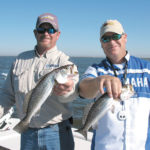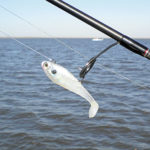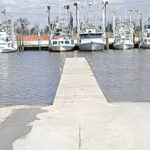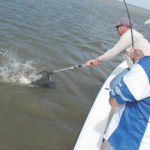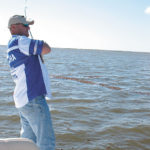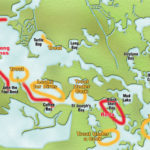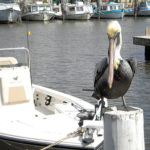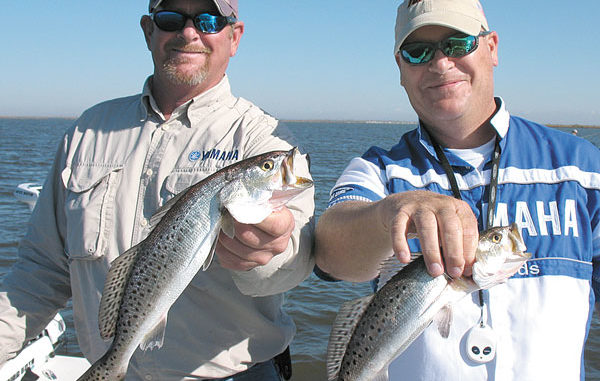
Trout have been biting for weeks at this popular port, and the action will only get better in April.
I knew it was going to be a good day on the water even before I left home. For one thing, we’d fallen into a pattern of persistent, blustery winds that were like Dracula — they wouldn’t die. Finally, a shift in the weather put a stake through its heart, and there opened a day of opportunity — a single day where the weather prognosticators said there’d be little or no wind.
On top of that, it was a day with decent tidal movement, and I had a trip all lined up with not one but two charter guides.
I’d arranged to fish with Capt. Todd Dufour (504-382-1830), who was already at the dock of the Lafitte Harbor Marina when I arrived, and he invited one of his long-time friends, Scott Poche’ (504-915-0392), to accompany us on our trout-finding quest into the inside waters of Lafitte.
Word was out that the trout were hitting baits in the Pen, and though this was getting late in the season to fish there, I assumed that’s where we’d go. Dufour had a brand new steed to take us there — a 23-foot Pathfinder HPS bay boat, powered by a Yamaha 250 SHO, and it was already launched and waiting. We loaded our gear aboard, and headed out for what I knew would be some serious trout fishing. After all, how often do you get a two-fer? Two guides, one boat and me.
I know from long experience that the trout action can be spotty this time of year, but with two guides to point the way, my expectations were high. We should find some fish!
Being something of a “boat guy,” it was only natural that I’d look over Dufour’s new ride on our journey to trout territory. This new model Pathfinder has higher sides and a modified step-bottom design that’ll handle bigger waters more capably. The Yamaha 250 SHO lets it cruise at 50 m.p.h., and gives it a top end of 60 or so, which is way more than enough.
Instead of heading toward the Pen for the last of the trout bite, Dufour took us out toward the real springtime action spots around Little Lake. A late-season chill made our boat ride cooler than expected, and the cruising speed of Dufour’s hot rod bay boat kept me huddled behind the seat.
But the positive side of a fast ride is that you arrive quickly at your target area, and Dufour let the boat come to a stop well before the area he planned to fish.
“By now the transition is usually over and the trout are making their way to the outside waters,” Dufour said as he lowered the trolling motor over the bow. “It’s not too soon to poke your nose out around Manila Village and even Saturday Island.
“But if we get a late-season cold front or the water temperature doesn’t warm up very fast, the trout may not show up out there until May,” he said. “But you can be sure they will be there in good numbers once the conditions are right, if they’re not there already.”
But we didn’t head that far down for our quest. We were poking along the bottom of Little Lake looking for any signs of baitfish. Some of the water we passed looked dirty, due no doubt to all the winds we’d been having. So we looked for cleaner water, and we looked for bait.
“We’re just a tad early for the birds to show up, but by April you should see them diving over some schools of shrimp,” Dufour said. “We never know the exact time they’ll show up because so many factors are involved — how fast the shrimp grow, water temperatures, salinities, tides, etc. — but sometime this month the birds will show up, and when they do, fish there.”
The area we were in was definitely the hot zone. I counted a dozen boats all in the same area, and all were doing the same thing — drifting and casting plastics, either under popping corks or tight-lined. We crept into an empty section far enough away from the other boats so as not to cramp anybody’s style, and we started casting.
My baitcasting rig was loaded with a ¼-ounce plain short-shank jighead and a Deadly Dudley Terror Tail in opening night/chartreuse. Both Dufour and Poche’ were casting a Storm Wildeye soft plastic swim bait in a silver color, and we were all tight-lining. We’d cast in all directions, let our bait sink in the shallow water to the bottom, and then reel it in in spurts, letting it dribble across the bottom. It wasn’t long before we started getting some hits.
At first we had a few “drive-bys,” where they pull at your bait without actually committing to take it, but then they started getting more serious, and we started catching some fish. We’d drifted into a pocket of activity, and for several minutes we all caught some decent-sized trout, one after another.
“The trout aren’t huge right now, at least not here,” said Poche’. “This is the typical size for this area this month.
“But they’re the perfect eating size,” he said, as he dropped one in the box and cast back to catch another.
The two captains were outcatching the writer by a margin better than two-to-one, and rather than blame my prowess with a fishing rod, they suggested I switch to one of their swim baits.
Storm and Tsunami and several other tackle companies are making soft-plastic swim baits that both Poche and Dufour find slightly more productive at this time of year. Normally, they use a cocaho-tail bait like an H&H or Salt Water Assassin, or the larger beetle tails in colors like smoke/white, avocado/white and electric chicken, but they prefer these swim baits in March and April. So I switched, and saw my production pick up a notch or two. Maybe it was the bait, and maybe we just drifted into an area with more aggressive fish. But I left the swim bait on and fished productively with it the rest of the morning.
We went through a few periods of frantic action, and some of no action, which is also typical when drifting an area. Normally you’d turn around and re-drift the most productive areas. The problem with doing that is it is very difficult to actually find that same area you caught the fish in in an open lake.
“That’s why you have to use your instruments — your depth sounder and your GPS,” Dufour said. “When you’re drift fishing and you get into the action, you can do two things. One, put your anchor down. A PowerPole or Cajun anchor would be best because it’s shallow water and it’s quieter. Then you try to stay with the action for awhile. Sometimes this works fine, and you catch a bunch of fish. But sometimes it’s like putting poison in the water, and when you stop drifting, you stop catching.
“I tell anglers that when you’re drifting in an area and the fish are hitting good, take a few seconds and look at your depth sounder and notice the contour of the bottom. You’ll likely be in an area with some irregularities on the bottom — lumps, clumps of grass or shells or mud, slight ridges or anything at all that provides the slightest hiding places for bait.
“Now sometimes, you’ll see absolutely no rhyme or reason for the fish to be in that particular spot. But usually you can detect some irregularities on the bottom, and that’s what you look for. Use your depth sounder, find those irregularities, and you’ll likely find fish.
“The second thing you can do if you don’t want to put the PowerPole down is check your GPS. Note the coordinates, and when you want to re-drift that productive area, you’ll know right where to go.”
I looked around at the dozen other boats fishing within sight of us, and noticed most of them were catching fish. Not on every cast, but pretty regularly, so the action wasn’t confined to our one spot but seemed to be spread over a wide area. I also noticed most of them were fishing under popping corks.
Dufour had already switched over to a popping cork rig and caught a nice trout on his first cast. I put down my baitcasting rig and picked up my spinning rig, already rigged with a cork and plastic, and did the same.
“I like to use smaller baits this time of year,” Dufour said, showing me his sparkle beetle on a 1/8-ounce jig. “I use a few basic colors, root beer, smoke, off white and avocado, nothing too flashy.
“I find that the fish will more readily take a small bait this month than a big bait. You have to forget the adage, ‘big bait for big fish,’ at least for now. That’ll be true in May and June, but for now, downsize your bait until summer, and you’ll catch more fish.”
Dufour said the trout action should be good throughout the month in areas like Little Lake, Plum Point, the northeast corner of Turtle Bay, Black Shell Bay and the islands around Red Eye Cut.
“From Coffee Bay and south and all the way to the north edge of Hackberry Bay is where the shrimp show up first — all that area will come alive sometime this month or next,” he said. “But you’ll want to start looking for the birds anywhere between Plum Point to Red Eye Cut, because that’s where they usually start showing up in good numbers.
“If you don’t see the birds, then look for clean water, current and signs of baitfish.”
All the while we were consistently adding trout to the box, and by this time we had quite a collection.
“That’s No. 60,” Poche said, as he dropped in yet another speck.
These fish were biting steady, and as much as I hated to leave the action, I was ready to try for some reds. The specks were cooperative and we could easily have filled our limit, but I suggested we hunt for a few reds before calling it a day.
Dufour said the redfish will likely be scattered across the whole region this month.
“I don’t usually find them all schooled up in April, so you’ll have to hunt and peck at them,” he said. “Keep moving, picking them up one or two at a time as you go.
“I’ll fish the ponds behind Bayou Dupont, the ponds around Red Eye Cut and Black Shell Bay and along the outer edges of Hackberry Bay. On a falling tide, I’ll fish the drains along the bottom of Airplane Bay.
“I find that the key is to fish the ponds when the tide is up, and fish the drains when it’s falling. Look for clean water, and use spinnerbaits, spoons, soft plastics in black/chartreuse or the chicken on a chain color. On the tough days, toss a Gulp shrimp in the moulting or natural color, under a cork. The reds will hit that as quickly as dead shrimp.”
We worked our way along a ragged shoreline where the water was so stained I couldn’t see my bait 6 inches down.
“Gulps under a cork,” Dufour said, and we all loaded up with the same thing.
In minutes we had two reds on, and over the next hour, we caught and released at least a dozen more.
You see, I knew from the start this was going to be a good day.
